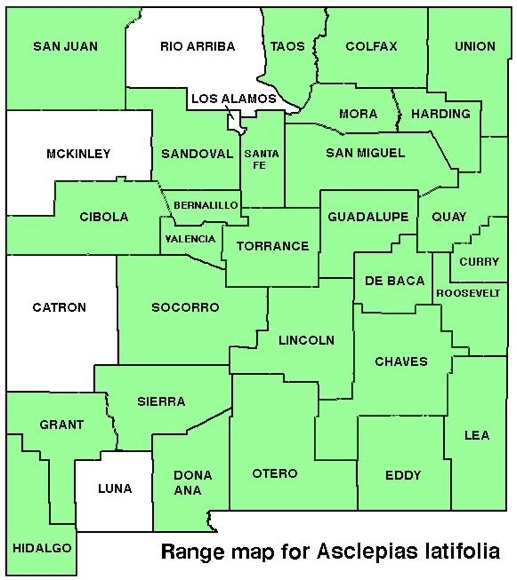WILDFLOWERS OF NEW MEXICO

Like a deck of cards, the thick, wide leaves of this distinctive milkweed are closely stacked up along an erect, 2–3-foot tall (60–90) stem. Note the 2–3 inch wide (5–8 cm) clusters of creamy to greenish flowers nestled within the leaves. The sap is milky.
FLOWERS: June–October. The 5 petal-like lobes bend back against the stem, and the horns extend slightly beyond the hoods toward the central anther column. The fruit, a 2 3/4–3 1/2 inch long (7-9 cm), smooth pod with a tapering tip, is on a stem bent back against the pod (not S-shaped). The pod dries and splits open to release numerous seeds on feathery plumes.
LEAVES: Opposite to loosely whorled around the stem, stalkless (sessile) or on short stalks (petioles) to 1/2 inch long (0–15 mm). Thick, shinny, stiff blades, 3–6 inches long (7.6–15.2 cm) and half as wide, are elliptic to egg-shaped with a tapering base, and prominent parallel veins that radiate from the midvein.
HABITAT: Rocky, sandy soils, dry prairies, mesas, roadsides; desert grasslands and scrub, pinyon-juniper woodlands.
ELEVATION: 3,800–6,800 feet.
RANGE: AZ, CA, CO, KS, NE, NM, OK, SD, TX, UT.
SIMILAR SPECIES: The widespread but at ranging to higher elevations (to 8,200 feet), Showy Milkweed, A. speciosa, has opposite leaves spaced widely on the stem, dense, rounded clusters of pinkish flowers, and pods with pointed warts.
NM COUNTIES: Nearly statewide in low- to mid-elevation, dry habitats: Bernalillo, Chaves, Cibola, Colfax, Curry, De Baca, Dona Ana, Eddy, Guadalupe, Grant, Harding, Lea, Hidalgo, Lincoln, Mora, Otero, Quay, Roosevelt, San Juan, San Miguel, Sandoval, Santa Fe, Sierra, Socorro, Taos, Torrance, Union, Valencia.









BROADLEAF MILKWEED
ASCLEPIAS LATIFOLIA
Dogbane Family, Apocynaceae (formerly Milkweed Family, Asclepiadaceae)
Perennial herb
THE CONTENTS OF THIS WEBSITE ARE COPYRIGHTED AND CANNOT BE USED
WITHOUT PERMISSION OF GEORGE OXFORD MILLER



































Inflated hoods (right arrow) of the flower surround the thin, pointed horns (left arrow) that arch toward the central anther column.



















EMAIL ME







